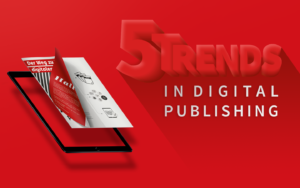What can publishers do better?
Subscription models were a tried and tested medium in the newspaper and magazine industry for decades – until the introduction of the iPhone ten years ago. Since then, publishers and media houses have been increasingly struggling with declining subscriber numbers. To complicate matters, numerous niche magazines are competing for the small readership pool.
Paradoxically, subscription models in branches such as film, music and retail are gaining in importance. So what’s going on? What are the market leaders in the subscription sector doing differently? And what can publishers and media do better to secure future readers? We try here to shed light on the issue and make some suggestions for your subscription models.
A closer look at Spotify, Netflix and Co.
The film and music industry were given a much-needed boost by streaming services. And subscription models from the retail trade, from ironed shirts to razor blades, are increasingly finding customers. The key to such success is relatively simple. There is a great variety of offers out there, which can sometimes be overwhelming. The desire to have controlled and manageable access to ones favourite music or series competes with the excitement of trying out something new. These subscription models offer both.
Many users benefit from such flexible accounts, which allow access to content on all devices.
Additionally, with flexible subscription lengths and notice periods, the user has more autonomy and doesn’t feel tied down. The monthly rates are manageable, and even a real bargain with family and friends accounts. The accounts can be expanded or cancelled with just one click.
It’s not surprising that readers desire such a service from print subscriptions.
Facts from current studies
At the VDZ Distribution Summit in October, the VDZ together with the Siegfried Vögele Institute presented the study “Future of the Subscription – What the reader wants! First results of a large population survey” The responses of around 2,000 respondents aged between 14 and 75 contain interesting indications on what readers expect from print subscriptions.
The study gets straight to the point and lists factors leading to subscriptions being cancelled: decreasing interest in the product (24%), overpriced and underutilized subscriptions (23%), discontinuation of the favourable subscription model (21%) and too little time to read (17%).
These answers are not surprising. Subscriptions are only slightly less costly than single purchases; reductions for permanent readers or students are rare.
In addition, participants were asked about their prior expectations concerning the subscription and how these compared to reality. Reality clearly split with expectation when it came to unlimited access to normal and exclusive content or the availability of the magazines on laptop and smartphones without additional charges.
At the same time there is a lot of potential in the subscription market. 44% of respondents can imagine subscribing to a magazine in the future – provided services such as punctual delivery, a favourable price relative to the retail purchase, flexible duration and notice periods, as well as additional premiums during the subscription period are met.
The study results already clearly indicate how future subscription models can be designed. Some of these can most certainly be applied to your subscriptions.
Choice encourages individuality: Print & digital
Your readers should not have to decide between print and digital. Simply offer your print subscriptions in combination with digital editions along with a digital-only subscription for mobile or environmentally-conscious readers. Bundle-subscriptions can be easily managed using magazine apps and access codes or individual reader accounts.
Another possibility is a print-on-demand subscription. A digital subscription can include the option to reorder individual editions as a print copy. Additional costs can be charged via monthly invoices or you can set a fixed price for such a subscription combination.

Digital or print? — Give the reader a choice
Bundle-subscriptions with related topics
Along with form, content can also be used to define a subscription. What about a package of theme- or product-related magazines? A trade publisher can offer three cookery magazines in a package (at a lower price of course). Another alternative might be a duo subscription for couples with two magazines from the assortment, e.g. a “GQ” for him and a “Glamour” for her.
Multiple accounts for a magazine
These days you could be forgiven for thinking that every flat share and every group of young friends shares a Netflix premium account. After all, with access on up to five different screens for 14 euros monthly, it’s pretty much unbeatable. This is not to say that you should underprice your magazines, but merely provide easier access. The classic print magazine is generally read by all family members or flatmates. Why not allow digital access to the magazine from several devices?
You gain additional readers, who in the long term could sign up for their own subscriptions.
Flexibility and periods of notice
Even though lengthier subscriptions and periods of notice confer long-term planning security, not everyone is ready for a long term commitment. Whether this is due to lack of time or finances or simply the extra hassle, you need to react. Offer subscription lengths and notice periods on a monthly basis that can be conveniently managed through an online account and through your reader service.
The option to pause a subscription, for example during the holiday, also gives the customer more elbow room. You’ll find that granting the reader this autonomy and freedom of choice takes away the pressure and encourages their curiosity. You’ll benefit from satisfied readers, who you can win over in the long term with great service and content.
Also, in the spirit of flexibility, check out the payment methods for your subscriptions. Do you offer enough choice?

With multiple accounts, readers can read on multiple devices at the same time.
Test and trial subscriptions – the pathway to regular customers
Many publishers already offer the classic trial subscriptions or free booklet to entice future readers and subscribers. Target existing subscribers with these offers – most consumers listen to tips and recommendations from friends, family and experts before trying out or buying a product. A refer-a-friend subscription or a free trial issue create incentives for readers to recommend your magazine. With a magazine app, unlocking single editions is uncomplicated.
Flat-rate reading
Providers such as Readly and Amazon Prime Reading have completely integrated the concepts of Spotify and Netflix into the world of publishing. For a monthly fee the reader has access to a wide range of magazines. But what’s good for the reader isn’t necessarily good for the publisher. Flat-rate billing, charging according to pages read, or having to share a substantial portion of the revenue is rarely financially profitable.
If you wish to offer readers a wide selection of magazines for an acceptable price in the future, a kiosk app may be the solution you are looking for. You can provide your whole range of magazines or a selection in an app that readers can unlock for a monthly subscription. The advantage over third-party providers is an in-house product in your own design without additional financial investment and without competitors. You also determine the structure, the categorization and the prices.
Find what works for you
Providing an all-round service at a low price is a thorny issue in publishing and media because of the value of the content. Good content requires creativity and time-consuming research. Nobody wants to give it away for free or sell under value. However, the changing world of media usage and the reader’s desire for varied content means a rethink is necessary. And the more flexible and versatile the offers and subscription models are, the more readers they will attract. Familiarise yourself with the different possible subscription models and test out how readers respond to changes.
The study presented at the VDZ Publisher Summit will be complemented by the VDZ Publisher Summit on 6th and 7th November in Berlin. PressMatrix will be attending and look forward to seeing you there!

